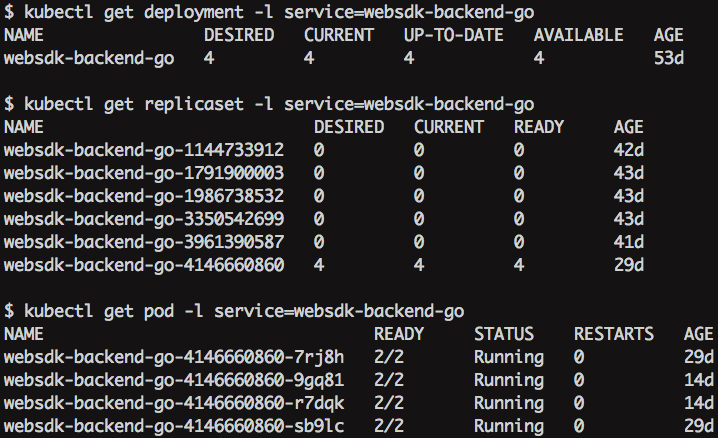Rolling Updates with Kubernetes Deployments
Learn how to use Kubernetes Deployment to perfom rolling update

Table of Contents
The newer version of Kubernetes, official suggests using Deployment instead of Replication Controller(rc) to perform a rolling update. Though, they are same in many ways, such as ensuring the homogeneous set of pods are always up/available and also they provide the ability to help the user to roll out the new images. However, Deployment provides more functionalities such as rollback support.
A Deployment owns and manages one or more ReplicaSets. And Replica Set manages the basic units in Kubernetes - Pods.
Why Deployment manages multiple ReplicaSets? The answer is Kubernetes wants to support rollback mechanism. Kubernetes creates a new ReplicaSet each time after the new Deployment config is deployed and also keeps the old ReplicaSet. So that we can rollback to the previous state with old ReplicaSet. And there is only one ReplicaSet is in active state, which means DESIRED > 0.

Let’s create a Deployment with the following deployment yaml file nginx.yaml.
apiVersion: extensions/v1beta1
kind: Deployment
metadata:
name: nginx
spec:
replicas: 3
template:
metadata:
labels:
service: http-server
spec:
containers:
- name: nginx
image: nginx:1.10.2
imagePullPolicy: IfNotPresent
ports:
- containerPort: 80
You can use kubectl create or kubectl apply to create nginx deployment.
$ kubectl create -f nginx.yaml
deployment "nginx" created
Use kubectl to retrieve the current status of nginx deployment.
$ kubectl get deployment
NAME DESIRED CURRENT UP-TO-DATE AVAILABLE AGE
nginx 3 3 3 3 8m
As I mentioned before, Deployment manages ReplicaSets and ReplicaSet manages Pods.
└─ Deployment: <name>
└─ ReplicaSet: <name>-<rs>
└─ Pod: <name>-<rs>-<randomString>
Kubernetes will create the replicaset for us after the creation of deployment.
$ kubectl get rs
NAME DESIRED CURRENT AGE
nginx-3322722759 3 3 8m
And the Replica Set will create pods after its been created.
$ kubectl get pod -l "service in (http-server)"
NAME READY STATUS RESTARTS AGE
nginx-3322722759-7vp34 1/1 Running 0 14m
nginx-3322722759-ip5w2 1/1 Running 0 14m
nginx-3322722759-q97b7 1/1 Running 0 14m
In order to support rolling update, we need to configure the update strategy first.
So we add following part into spec
minReadySeconds: 5
strategy:
# indicate which strategy we want for rolling update
type: RollingUpdate
rollingUpdate:
maxSurge: 1
maxUnavailable: 1
- minReadySeconds:
- the bootup time of your application, Kubernetes waits specific time til the next pod creation.
- Kubernetes assume that your application is available once the pod created by default.
- If you leave this field empty, the service may be unavailable after the update process cause all the application pods are not ready yet
- maxSurge:
- amount of pods more than the desired number of Pods
- this fields can be an absolute number or the percentage
- ex. maxSurge: 1 means that there will be at most 4 pods during the update process if replicas is 3
- maxUnavailable:
- amount of pods that can be unavailable during the update process
- this fields can be a absolute number or the percentage
- this fields cannot be 0 if
maxSurgeis set to 0 - ex. maxUnavailable: 1 means that there will be at most 1 pod unavailable during the update process
The final nginx.yaml would be like the following
apiVersion: extensions/v1beta1
kind: Deployment
metadata:
name: nginx-test
spec:
replicas: 10
selector:
matchLabels:
service: http-server
strategy:
type: RollingUpdate
rollingUpdate:
maxSurge: 1
maxUnavailable: 1
minReadySeconds: 5
template:
metadata:
labels:
service: http-server
spec:
containers:
- name: nginx
image: nginx:1.10.2
imagePullPolicy: IfNotPresent
ports:
- containerPort: 80
Lets apply the new nginx.yaml
$ kubectl apply -f nginx.yaml --record
Now, for example, if we want to update the docker image, we have three ways to perform the rolling update.
set image
# format
$ kubectl set image deployment <deployment> <container>=<image> --record
# example
$ kubectl set image deployment nginx nginx=nginx:1.11.5 --record
replace
Modify the container image version in nginx.yaml (1.10.2)
spec:
containers:
- name: nginx
# newer image version
image: nginx:1.11.5
imagePullPolicy: IfNotPresent
ports:
- containerPort: 80
Using replace here instead of apply
# format
$ kubectl replace -f <yaml> --record
# example
$ kubectl replace -f new-nginx.yaml --record
edit
# format
$ kubectl edit deployment <deployment> --record
# example
$ kubectl edit deployment nginx --record
This command opens the editor, and you just need to change the image version in it.
# Please edit the object below. Lines beginning with a '#' will be ignored,
# and an empty file will abort the edit. If an error occurs while saving this file will be
# reopened with the relevant failures.
#
apiVersion: extensions/v1beta1
kind: Deployment
metadata:
annotations:
deployment.kubernetes.io/revision: "1"
kubectl.kubernetes.io/last-applied-configuration: '{"kind":"Deployment","apiVersion":"extensions/v1beta1","metadata":{"name":"nginx","creationTimestamp":null},"spec":{"replicas":10,"template":{"metadata":{"creationTimestam
...
spec:
containers:
- image: nginx:1.10.2
imagePullPolicy: IfNotPresent
name: nginx
...
$ kubectl rollout status deployment nginx
$ kubectl rollout pause deployment <deployment>
$ kubectl rollout resume deployment <deployment>
After the image update, your colleague finds the service become unstable you may want to go back to the previous version. Unfortunately, he/she dunno how the previous config looks like. Well, you don’t need the time machine, just let rollback to do its job.
At previous part, the parameter --record comes with command let the Kubernetes record the command you typed, so that you can distinguish between the revisions.
$ kubectl apply -f nginx.yaml --record
deployment "nginx" configured
$ kubectl set image deployment nginx nginx=nginx:1.11.5 --record
deployment "nginx" image updated
$ kubectl rollout history deployment ngin
deployments "nginx":
REVISION CHANGE-CAUSE
1 kubectl apply -f nginx.yaml --record
2 kubectl set image deployment nginx nginx=nginx:1.11.5 --record
Now, lets go back to revision 1
# to previous revision
$ kubectl rollout undo deployment <deployment>
# to specific revision
$ kubectl rollout undo deployment <deployment> --to-revision=<revision>
# exmaple
$ kubectl rollout undo deployment nginx --to-revision=1
All revision history is stored in the ReplicaSets that deployment controls. If you want to keep more revision history, please set .spec.revisionHistoryLimit in yaml to specify the number of old ReplicaSets to retain to allow rollback. (set this field at the first time apply)
...
spec:
replicas: 10
selector:
matchLabels:
service: http-server
strategy:
type: RollingUpdate
rollingUpdate:
maxSurge: 1
maxUnavailable: 1
minReadySeconds: 5
revisionHistoryLimit: 10
...
$ kubectl rollout history deployment/nginx
deployments "nginx":
REVISION CHANGE-CAUSE
2 kubectl set image deployment nginx nginx=nginx:1.11 --record
3 kubectl set image deployment nginx nginx=nginx:1.11.5 --record
4 kubectl set image deployment nginx nginx=nginx:1.10 --record
5 kubectl set image deployment nginx nginx=nginx:1.10.2 --record
- Please add labels to the
spec.template.metadata.labels
The Deployment "nginx" is invalid.
* spec.selector: Required value
* spec.template.metadata.labels: Invalid value: null: `selector` does not match template `labels`
- http://kubernetes.io/docs/user-guide/deployments/
- http://kubernetes.io/docs/user-guide/kubectl/kubectl_rollout_history/
- https://youtu.be/wVMXjDoeRS4?t=3381
- http://kubernetes.io/docs/user-guide/kubectl/kubectl_rolling-update/
- http://kubernetes.io/docs/user-guide/replication-controller/
See Also
- Kubernetes - Two Steps Installation
- Kubernetes - Installation
- Kubernetes - Pod
- Kubernetes - High Availability
- Adopting Container and Kubernetes in Production
To reproduce, republish or re-use the content,
please attach with link: https://tachingchen.com/

Twitter
Google+
Facebook
Reddit
LinkedIn
StumbleUpon
Pinterest
Email